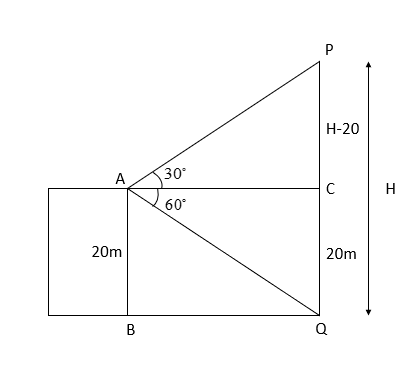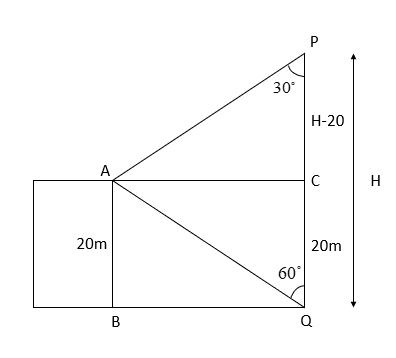
From the top of a building 20meter high, the angle of the elevation of the top of a vertical pole is ${{30}^{\circ }}$, and the angle of depression of the foot of the same pole is ${{60}^{\circ }}$. Find the height of the pole.
Answer
573.9k+ views
Hint: We solve this problem by assuming the height of the pole as H. Then we make a rough picture of the given information. Then we consider the tangent of angle of elevation and tangent of angle of depression using the formula, $\tan \theta =\dfrac{\text{Opposite}}{\text{Base}}$. Then we compare them to find the value of height of the pole.
Complete step-by-step answer:
We are given that angle of elevation of the top of the pole is ${{30}^{\circ }}$ and the angle of depression of the foot of the pole is ${{60}^{\circ }}$, from the top of a building of height 20m.
Let the top of the pole be P and foot of the pole be point Q and let the height of the pole be H meters.
Let the top of the building be A.

Now let us consider the triangle ACP. It is a right angled triangle with base AC. Let us consider the formula for tangent of any angle
$\tan \theta =\dfrac{\text{Opposite}}{\text{Base}}$
In $\Delta ACP$, the angle PCA is equal to ${{30}^{\circ }}$, as we are given that angle of elevation of the top of pole is ${{30}^{\circ }}$. Let us applying the tan to the angle PCA using the above formula.
$\begin{align}
& \Rightarrow \tan \angle PAC=\dfrac{PC}{AC} \\
& \Rightarrow \tan {{30}^{\circ }}=\dfrac{PC}{AC} \\
& \Rightarrow \dfrac{1}{\sqrt{3}}=\dfrac{PC}{AC} \\
& \Rightarrow AC=\sqrt{3}PC.............\left( 1 \right) \\
\end{align}$
Now let us consider the triangle ACQ. It is a right-angled triangle with base AC.
In $\Delta ACQ$, the angle QCA is equal to ${{60}^{\circ }}$, as we are given that angle of elevation of the top of pole is ${{60}^{\circ }}$. Let us applying the tan to the angle QCA.
$\begin{align}
& \Rightarrow \tan \angle QAC=\dfrac{QC}{AC} \\
& \Rightarrow \tan {{60}^{\circ }}=\dfrac{QC}{AC} \\
& \Rightarrow \sqrt{3}=\dfrac{QC}{AC} \\
& \Rightarrow AC=\dfrac{QC}{\sqrt{3}}.............\left( 2 \right) \\
\end{align}$
Now, as we see the equations (1) and (2), both are the values of AC. So, we can equate the equations (1) and (2).
$\begin{align}
& \Rightarrow \sqrt{3}PC=\dfrac{QC}{\sqrt{3}} \\
& \Rightarrow 3PC=QC \\
\end{align}$
From the diagram we can see that the lengths of PC and QC are H-20 and 20 meters respectively. So, substituting them in the above equation we get,
$\begin{align}
& \Rightarrow 3\left( H-20 \right)=20 \\
& \Rightarrow 3H-60=20 \\
& \Rightarrow 3H=80 \\
& \Rightarrow H=\dfrac{80}{3} \\
\end{align}$
So, we get that the height of the pole is $\dfrac{80}{3}$m.
Hence, the answer is $\dfrac{80}{3}$m.
Note: The main mistake one does while solving this problem is one might mistake the angle of elevation and angle of deviation. One might take the diagram as

But it is wrong. The angles of elevation and depression are the angle between the line joining the object and eye and the horizontal line.
Complete step-by-step answer:
We are given that angle of elevation of the top of the pole is ${{30}^{\circ }}$ and the angle of depression of the foot of the pole is ${{60}^{\circ }}$, from the top of a building of height 20m.
Let the top of the pole be P and foot of the pole be point Q and let the height of the pole be H meters.
Let the top of the building be A.

Now let us consider the triangle ACP. It is a right angled triangle with base AC. Let us consider the formula for tangent of any angle
$\tan \theta =\dfrac{\text{Opposite}}{\text{Base}}$
In $\Delta ACP$, the angle PCA is equal to ${{30}^{\circ }}$, as we are given that angle of elevation of the top of pole is ${{30}^{\circ }}$. Let us applying the tan to the angle PCA using the above formula.
$\begin{align}
& \Rightarrow \tan \angle PAC=\dfrac{PC}{AC} \\
& \Rightarrow \tan {{30}^{\circ }}=\dfrac{PC}{AC} \\
& \Rightarrow \dfrac{1}{\sqrt{3}}=\dfrac{PC}{AC} \\
& \Rightarrow AC=\sqrt{3}PC.............\left( 1 \right) \\
\end{align}$
Now let us consider the triangle ACQ. It is a right-angled triangle with base AC.
In $\Delta ACQ$, the angle QCA is equal to ${{60}^{\circ }}$, as we are given that angle of elevation of the top of pole is ${{60}^{\circ }}$. Let us applying the tan to the angle QCA.
$\begin{align}
& \Rightarrow \tan \angle QAC=\dfrac{QC}{AC} \\
& \Rightarrow \tan {{60}^{\circ }}=\dfrac{QC}{AC} \\
& \Rightarrow \sqrt{3}=\dfrac{QC}{AC} \\
& \Rightarrow AC=\dfrac{QC}{\sqrt{3}}.............\left( 2 \right) \\
\end{align}$
Now, as we see the equations (1) and (2), both are the values of AC. So, we can equate the equations (1) and (2).
$\begin{align}
& \Rightarrow \sqrt{3}PC=\dfrac{QC}{\sqrt{3}} \\
& \Rightarrow 3PC=QC \\
\end{align}$
From the diagram we can see that the lengths of PC and QC are H-20 and 20 meters respectively. So, substituting them in the above equation we get,
$\begin{align}
& \Rightarrow 3\left( H-20 \right)=20 \\
& \Rightarrow 3H-60=20 \\
& \Rightarrow 3H=80 \\
& \Rightarrow H=\dfrac{80}{3} \\
\end{align}$
So, we get that the height of the pole is $\dfrac{80}{3}$m.
Hence, the answer is $\dfrac{80}{3}$m.
Note: The main mistake one does while solving this problem is one might mistake the angle of elevation and angle of deviation. One might take the diagram as

But it is wrong. The angles of elevation and depression are the angle between the line joining the object and eye and the horizontal line.
Recently Updated Pages
Why are manures considered better than fertilizers class 11 biology CBSE

Find the coordinates of the midpoint of the line segment class 11 maths CBSE

Distinguish between static friction limiting friction class 11 physics CBSE

The Chairman of the constituent Assembly was A Jawaharlal class 11 social science CBSE

The first National Commission on Labour NCL submitted class 11 social science CBSE

Number of all subshell of n + l 7 is A 4 B 5 C 6 D class 11 chemistry CBSE

Trending doubts
What is meant by exothermic and endothermic reactions class 11 chemistry CBSE

10 examples of friction in our daily life

One Metric ton is equal to kg A 10000 B 1000 C 100 class 11 physics CBSE

1 Quintal is equal to a 110 kg b 10 kg c 100kg d 1000 class 11 physics CBSE

Difference Between Prokaryotic Cells and Eukaryotic Cells

What are Quantum numbers Explain the quantum number class 11 chemistry CBSE




